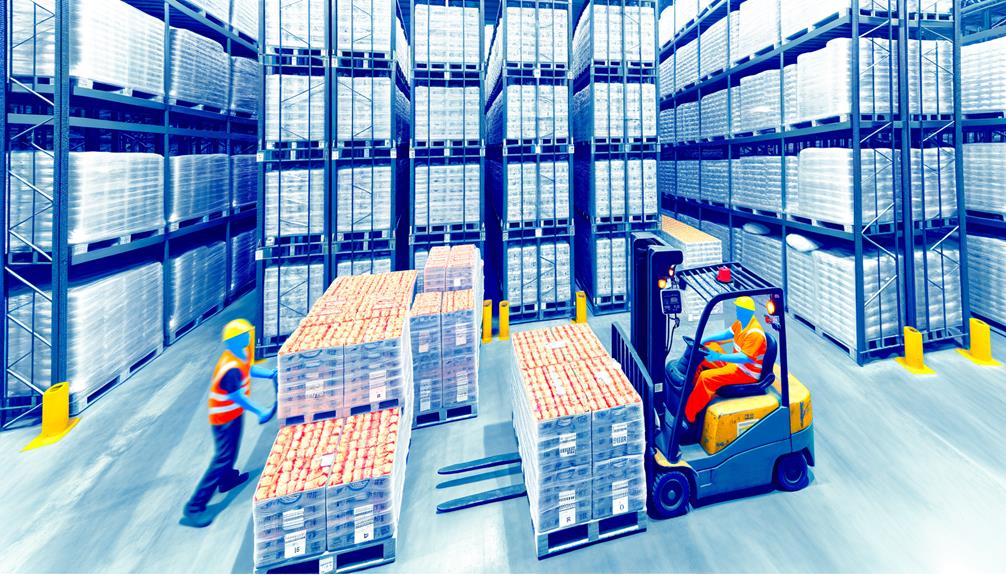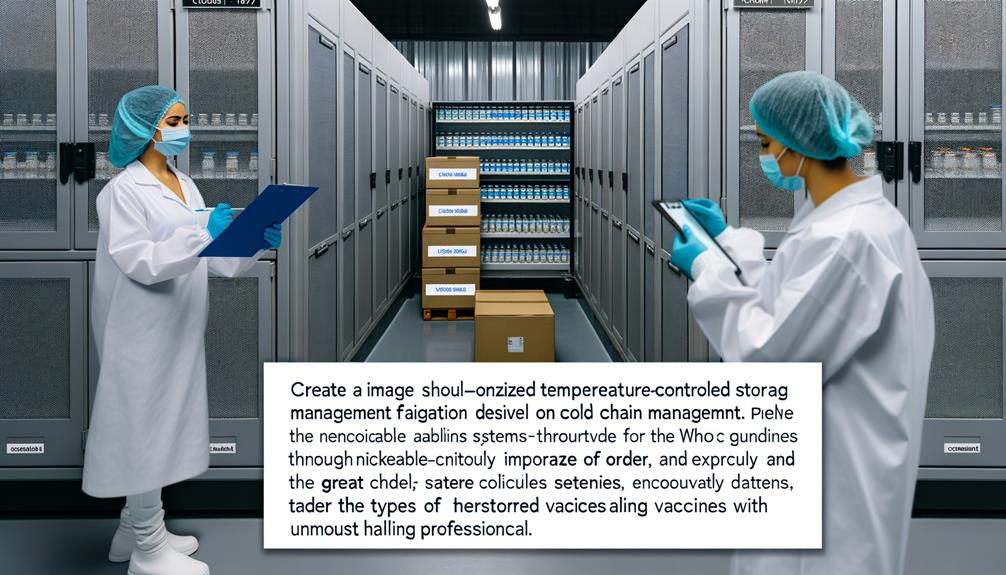Imagine a scenario where a pharmaceutical company successfully transports sensitive vaccines across the globe, ensuring that they maintain their efficacy and safety throughout the journey. This is just one example of the critical role that cold chain management plays in various industries.
The complexities and challenges of maintaining product integrity within a specified temperature range present a constant struggle for logistics and supply chain professionals. How can companies consistently achieve excellence in this realm, especially in the face of evolving regulations and technological advancements?
The answer lies in a comprehensive understanding of the key components of cold chain management and the implementation of effective strategies to navigate its intricacies.
Importance of Cold Chain Management
Ensuring proper cold chain management is vital for preserving the quality and safety of temperature-sensitive products throughout the supply chain. When temperatures fluctuate, it can compromise the integrity of products, leading to spoilage, reduced efficacy, or even posing health risks to consumers. Maintaining the cold chain mitigates these risks, ensuring that products such as pharmaceuticals, vaccines, and perishable foods remain safe and effective from production to consumption.
By adhering to cold chain protocols, you guarantee that products are stored, transported, and handled within specific temperature ranges. This is crucial for vaccines, as even slight deviations from recommended temperatures can render them ineffective. Similarly, perishable foods can spoil if exposed to temperature abuse during transit or storage.
Proper cold chain management also builds trust with consumers, as they can rely on the quality and safety of the products they purchase.
Key Components of Excellence
To achieve excellence in cold chain management, prioritize the implementation of key components that ensure the integrity and safety of temperature-sensitive products throughout the supply chain. The following components are crucial to achieving excellence in cold chain management:
- Temperature Monitoring and Control: Implement robust temperature monitoring systems and controls at every stage of the supply chain to ensure that products are consistently stored and transported within the required temperature range. This helps to prevent spoilage, maintain product quality, and uphold safety standards.
- Quality Packaging and Insulation: Utilize high-quality packaging materials and insulation to protect products from temperature fluctuations and external factors. Proper insulation and packaging are essential for preserving the integrity of temperature-sensitive goods, especially during transportation and storage.
- Regulatory Compliance and Documentation: Adhere to all relevant regulations and standards concerning cold chain management. Maintain accurate and detailed documentation of temperature records, handling procedures, and product information to demonstrate compliance and ensure traceability.
Temperature Monitoring and Control
Monitoring and controlling temperatures at every stage of the supply chain is crucial for ensuring the integrity and safety of temperature-sensitive products. From the moment the products are manufactured to the point of consumption, maintaining the required temperature range is essential.
To achieve this, it’s important to employ reliable temperature monitoring devices such as data loggers or real-time monitoring systems. These tools provide accurate and continuous temperature readings, allowing for immediate intervention if temperatures deviate from the specified range.
In addition to monitoring, effective temperature control measures must be in place. This includes utilizing temperature-controlled storage facilities, refrigerated vehicles, and insulated packaging. Implementing automated temperature control systems can also help regulate temperatures during transportation and storage, minimizing the risk of temperature excursions.
Furthermore, clear temperature monitoring and control protocols should be established and communicated across the supply chain. This ensures that all stakeholders understand their roles and responsibilities in maintaining the required temperature conditions. Regular training and audits can help verify compliance with these protocols, further enhancing the effectiveness of temperature monitoring and control measures.
Quality Assurance Measures
Implementing stringent quality assurance measures is essential for safeguarding the integrity and safety of temperature-sensitive products throughout the supply chain. To ensure the highest standards of quality in cold chain management, consider the following:
- Regular Audits: Conducting frequent, comprehensive audits of your cold chain processes and equipment is crucial for identifying any potential issues and ensuring compliance with industry regulations. This proactive approach demonstrates your commitment to maintaining the highest quality standards.
- Robust Documentation: Maintaining accurate and detailed documentation of every step in the cold chain process, including storage, handling, and transportation, provides a clear trail of accountability. This documentation not only facilitates traceability but also serves as a valuable resource for identifying areas of improvement.
- Continuous Training: Investing in ongoing training for all personnel involved in the cold chain ensures that everyone understands the importance of quality assurance measures and is equipped with the knowledge to uphold these standards. This commitment to training fosters a culture of excellence and accountability within your organization.
Technological Innovations
When considering technological innovations in cold chain management, it’s crucial to prioritize solutions that enhance real-time monitoring and control of temperature-sensitive products. One of the most impactful advancements in this area is the widespread adoption of IoT (Internet of Things) devices.
These devices provide continuous monitoring of temperature, humidity, and other relevant conditions throughout the entire supply chain, offering real-time data insights and alerts. This level of visibility enables proactive decision-making and rapid responses to any deviations from optimal storage conditions.
Additionally, the integration of RFID (Radio-Frequency Identification) technology allows for seamless tracking and tracing of products, enhancing transparency and accountability within the cold chain.
Furthermore, the implementation of advanced data analytics and machine learning algorithms has revolutionized cold chain management. These technologies enable predictive maintenance, forecasting of potential temperature excursions, and optimization of storage and transportation processes.
Regulatory Compliance
To ensure compliance with regulations, your cold chain management processes must adhere to strict standards for handling, storing, and transporting temperature-sensitive products. Failure to meet these standards can result in costly fines, damaged reputation, and even legal consequences.
Here are three crucial aspects to consider when it comes to regulatory compliance in cold chain management:
- Documentation: Accurate and detailed record-keeping is essential to demonstrate compliance with regulations. This includes maintaining records of temperature monitoring, storage conditions, and transportation logs. Failure to provide comprehensive documentation can lead to regulatory non-compliance issues.
- Training and Education: Properly trained personnel are vital to ensuring regulatory compliance in cold chain management. Regular training sessions on handling, storage, and transportation protocols should be conducted to keep staff informed and up to date with the latest compliance requirements.
- Regular Audits and Inspections: Conducting regular internal audits and inspections of your cold chain processes can help identify any potential compliance issues before they escalate. This proactive approach can prevent regulatory violations and maintain the integrity of your cold chain operations.
Risk Mitigation Strategies
Now that you understand the importance of regulatory compliance in cold chain management, let’s address effective risk mitigation strategies to safeguard your temperature-sensitive products throughout the supply chain.
Firstly, it’s crucial to establish clear communication and collaboration with all stakeholders involved in the cold chain. This includes suppliers, carriers, and distributors. Regular communication ensures that everyone is aligned with the necessary protocols and procedures, reducing the likelihood of errors or oversights.
Secondly, implementing robust temperature monitoring and control systems is essential. Utilize technology such as IoT-enabled sensors and data loggers to track and record temperature conditions at each stage of the cold chain. This real-time visibility allows for proactive intervention if any deviations occur, preventing potential product spoilage.
Moreover, developing contingency plans for various scenarios such as equipment malfunction or unexpected delays is vital. By having predefined strategies in place, you can minimize disruptions and swiftly address unforeseen challenges.
Lastly, conducting regular risk assessments and audits helps in identifying potential vulnerabilities and areas for improvement within the cold chain. This proactive approach allows for continuous optimization and enhancement of risk mitigation strategies.
Supply Chain Integration
You can enhance the efficiency and reliability of your cold chain management by integrating your supply chain processes. By doing so, you’ll streamline the flow of goods and information, leading to improved visibility and control over your entire supply chain. This integration will also enable better coordination between different stakeholders, reducing the chances of errors and delays. Additionally, it will allow for real-time monitoring and quick response to any issues that may arise, ultimately boosting the overall responsiveness of your cold chain management.
Embracing supply chain integration can bring about the following benefits:
- Increased Efficiency: Integration eliminates redundant processes and communication gaps, allowing for smoother operations and faster decision-making.
- Enhanced Collaboration: By integrating your supply chain, you can foster better collaboration among different departments and partners, leading to a more cohesive and synchronized approach.
- Improved Customer Satisfaction: With better visibility and control over your supply chain, you can ensure timely and accurate deliveries, ultimately enhancing customer satisfaction and loyalty.
Performance Metrics and KPIs
By proactively tracking performance metrics and KPIs, you can effectively gauge the impact of supply chain integration on your cold chain management’s efficiency and reliability.
Key Performance Indicators (KPIs) are essential tools for measuring the success of your cold chain management. Metrics such as on-time delivery, temperature deviations, and inventory accuracy provide valuable insights into the performance of your cold chain.
By monitoring these KPIs, you can identify areas for improvement and implement targeted strategies to enhance the overall efficiency and reliability of your cold chain.
Additionally, performance metrics can help you assess the effectiveness of your logistics partners and service providers. Tracking metrics related to carrier performance, warehousing operations, and transportation lead times can enable you to make informed decisions about your supply chain partners.
Furthermore, performance metrics and KPIs allow you to benchmark your cold chain operations against industry standards, helping you identify best practices and areas where you can strive for excellence.
Continuous Improvement Initiatives
Wondering how to continually enhance the efficiency and reliability of your cold chain management system? Implementing continuous improvement initiatives is crucial for staying ahead in the ever-evolving landscape of cold chain logistics. Here are three key strategies to drive ongoing enhancements:
- Regular Process Audits:
Conduct regular audits to identify inefficiencies, bottlenecks, and areas for improvement within your cold chain processes. By regularly assessing your operations, you can pinpoint potential issues and implement corrective measures swiftly, ensuring the smooth flow of your supply chain.
- Employee Training and Engagement:
Invest in ongoing training programs to keep your cold chain management team updated on the latest industry trends, technologies, and best practices. Engaged and knowledgeable employees are more likely to proactively identify improvement opportunities and contribute to a culture of continuous enhancement.
- Utilize Advanced Technologies:
Embrace cutting-edge technologies such as IoT sensors, real-time tracking systems, and data analytics to gain deeper insights into your cold chain operations. Leveraging these tools allows for proactive decision-making, predictive maintenance, and overall optimization of the cold chain network.
Industry Case Studies
To gain practical insights into the implementation of continuous improvement initiatives in cold chain management, industry case studies provide real-world examples of successful strategies and their impact on operational efficiency.
One compelling case study involves a pharmaceutical company that implemented RFID temperature monitoring technology throughout its cold chain. This technology enabled real-time tracking of temperature-sensitive products, reducing the risk of spoilage and ensuring compliance with regulatory requirements. As a result, the company experienced a significant decrease in product losses and improved overall supply chain transparency.
Another illuminating case study comes from the food industry, where a global logistics provider optimized its cold chain processes by employing data analytics and predictive maintenance. By analyzing historical temperature data and equipment performance, the company was able to proactively identify potential issues and prevent temperature excursions. This proactive approach led to a substantial reduction in equipment downtime and maintenance costs, ultimately enhancing the reliability and efficiency of their cold chain operations.
These industry case studies underscore the tangible benefits of embracing innovative technologies and data-driven strategies in cold chain management, showcasing how organizations can achieve operational excellence and ensure the integrity of temperature-sensitive products.
Frequently Asked Questions
How Does Cold Chain Management Impact the Overall Sustainability and Environmental Footprint of a Supply Chain?
Cold chain management impacts sustainability and environmental footprint by ensuring proper temperature control and reducing food waste. You’ll also minimize energy consumption and greenhouse gas emissions, leading to a more eco-friendly supply chain.
What Are the Potential Implications of Failing to Meet Regulatory Compliance in Cold Chain Management?
Failing to meet regulatory compliance in cold chain management can lead to costly fines, damaged reputation, and compromised product safety. Ensure adherence to regulations through proper monitoring, documentation, and staff training.
How Do Companies Effectively Integrate Cold Chain Management Into Their Broader Supply Chain Strategies?
You effectively integrate cold chain management into your broader supply chain strategies by implementing robust temperature monitoring systems, establishing clear communication channels, and ensuring seamless coordination between all stakeholders involved in the supply chain process.
What Are Some Common Challenges and Best Practices for Continuous Improvement in Cold Chain Management?
You face common challenges like temperature control and logistics in cold chain management. Best practices for continuous improvement include investing in technology, rigorous training, and regular audits to ensure compliance and efficiency.
Can You Provide Examples of Successful Industry Case Studies That Demonstrate Excellence in Cold Chain Management?
You can find successful industry case studies that demonstrate excellence in cold chain management. Companies like XYZ and ABC have implemented innovative solutions to maintain product quality and safety throughout the supply chain.
Conclusion
In conclusion, mastering cold chain management is crucial for ensuring the safety and quality of temperature-sensitive products.
By focusing on temperature monitoring, quality assurance, technological innovations, and supply chain integration, companies can achieve excellence in this area.
Implementing performance metrics and continuous improvement initiatives will further enhance the efficiency and effectiveness of cold chain management.
Learn from industry case studies and strive for excellence in every aspect of your cold chain operations.



